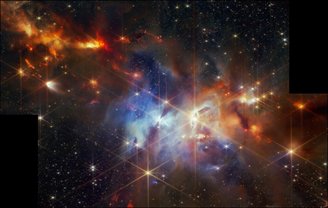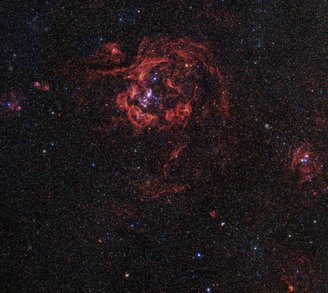Every week, TecMundo and #AstroMiniBR select the most interesting and relevant astronomy news to share with you the latest news from our vast universe. Check it out!
1. Lab-Replicated Martian Spiders
One of the phenomena Most intriguing on Mars are the formations known as “spiders” (or “araneiformes”). They were first discovered in 2003 through images captured by orbiting probes. The formations appear mainly in the southern hemisphere of Mars and have puzzled scientists for decades.
These structures are formed when carbon dioxide ice sublimates directly into gas in the Martian spring, creating fissures in the surface and sending up jets of dust and sand that form the characteristic web-like formations.
 Geological formations on the Martian soil in spider-like shapes.Source: NASA
Geological formations on the Martian soil in spider-like shapes.Source: NASA
This month, NASA scientists were able to recreate these spiders in the lab for the first time using the DUSTIE system at the Jet Propulsion Laboratory (JPL). The scientists simulated the low-pressure, extremely cold temperatures found in the polar regions of Mars, and by heating simulated Martian soil covered in CO2 ice, the researchers were able to replicate the gas jets and spiral formations that resemble those seen on Mars.
This experiment not only validates the spider formation model, but may also provide valuable information for future missions to Mars. Better understanding these geological processes helps refine landing sites and the tools needed to study the Martian surface more effectively.
2. The beautiful Serpent Nebula
Stunning images of Serpent Nebula captured by the James Webb Space Telescope revisits a fascinating discovery: For the first time, astronomers have observed aligned gas streams from forming stars, confirming long-held theories about star formation.
 The Serpent NebulaSource: NASA
The Serpent NebulaSource: NASA
These gas streams, known as bipolar jets, are ejected by newborn stars and collide with the surrounding gas, creating visible plumes of molecular hydrogen and carbon monoxide. The alignment of these streams indicates that during the formation process, the stars rotate in a common direction, which is consistent with the rotation of the gas clouds that collapse to form these stars.
This discovery helps to better understand the dynamics of the birth of young stars, in addition to offer a glimpse of regions that were previously invisible to optical telescopes due to the dense surrounding dust.
3. The Andromeda Galaxy Revisited
 The Andromeda Galaxy observed by the Hubble telescope with artificial coloring.Source: NASA
The Andromeda Galaxy observed by the Hubble telescope with artificial coloring.Source: NASA
The Hubble Space Telescope has captured a new, detailed image of the Andromeda Galaxy, one of our closest galactic neighborss. The galaxy, located about 2.5 million light-years from Earth, has been re-presented in a beautiful image that highlights the vast regions of ionized gas that fuel the formation of new stars.
Studies of this type are essential to understanding how galaxies evolve over time, as well as providing a new glimpse of the object that will mark the future of the Milky Way, since these galaxies are on a collision course, predicted to happen over the next 6 to 10 billion years.
Did you like the content? Then stay up to date with all the latest astronomy news here at TecMundo. See you next Monday!